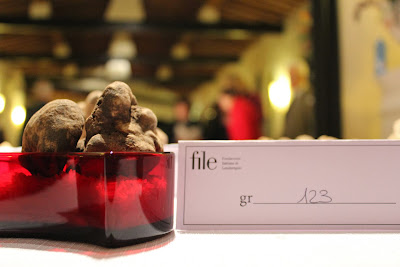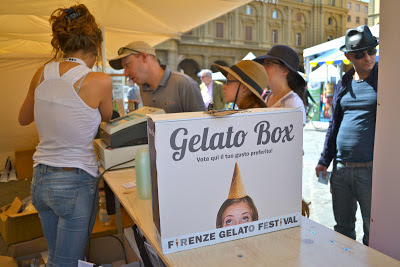Just before the holidays, I was walking down via de' Lamberti for the nth time, looked up, and suddenly saw the incarnation of Beautiful Florence's Christmas card to the world.
This sculpture composition is located in a niche on the church of Orsanmichele near via Calziauoli.
The Orsanmichele was initially a monastery with a vegetable garden (orto), rebuilt as a grain market and finally as a grain warehouse and church in the 14th century. It is a perfect synthesis of the two omnipresent sides of Florence's soul--sacred and the commercial.
In the late 1390s, Florence was a self governing republic under the direction of the city guilds.
The Orsanmichele was given to the guilds, which commissioned statues of protector saints to represent each one individually on the facade. The works were completed by artists as important as
Donatello, Verrocchio and Giambologna.
The above scene, as I discovered, however, was assigned to a relatively obscure sculptor, Pietro di Giovanni Tedesco, who is best known for his marble statues on the facade of the Cathedral (Duomo) now found in the Cathedral (Opera del Duomo) museum. He completed his original vision of
The Madonna of the Rose in 1399.
What you see above is an exact copy in the original niche, with the Tedesco's work now inside the Orsanmichele church. This fact does not detract from the beauty and power of the work, which typifies the moment in artistic history, the transition from Gothic to early Renaissance values. The Madonna mother, while realistically depicted, has the austere countenance and tiara of a Gothic queen, which she is, albeit a spiritual one. Looking ahead to the Renaissance, the Christ is a child with a humanistic face, curls, a smile and all. He is playfully reaching for the roses that his Mother is holding.
The group is seven ft. high, and while in marble, and the figures and drapery folds so beautifully done as to appear preserved in stone for posterity.
An interesting note: The Madonna of the Rose was chosen by the medieval Physicians and Apothecaries guild. Healers, with strong roots in the earth. The Child is holding a bird, a symbol of
freedom and space, and is reaching for the flowers, which stand for nature, beauty and intuition.
Sculptor Pietro di Giovanni Tedesco is believed to be an oriundo, born of Italian parents in either Germany or Flanders, as evidenced by the "Tedesco" (German) tacked on to his name.
It took another oriundo, born in America and author of
Beautiful Florence, to recognize a
paseano.
Faithful Beautiful Florence blog photographer Janelle Piva recorded this image which portrays
the physical and the divine aspects of the Virgin and Child.
And isn't that what Christmas is all about?
...and universal love of course.
Reporting live from Beautiful Florence
--Rose Anna Maria aka Rosanna
This sculpture composition is located in a niche on the church of Orsanmichele near via Calziauoli.
The Orsanmichele was initially a monastery with a vegetable garden (orto), rebuilt as a grain market and finally as a grain warehouse and church in the 14th century. It is a perfect synthesis of the two omnipresent sides of Florence's soul--sacred and the commercial.
In the late 1390s, Florence was a self governing republic under the direction of the city guilds.
The Orsanmichele was given to the guilds, which commissioned statues of protector saints to represent each one individually on the facade. The works were completed by artists as important as
Donatello, Verrocchio and Giambologna.
The above scene, as I discovered, however, was assigned to a relatively obscure sculptor, Pietro di Giovanni Tedesco, who is best known for his marble statues on the facade of the Cathedral (Duomo) now found in the Cathedral (Opera del Duomo) museum. He completed his original vision of
The Madonna of the Rose in 1399.
What you see above is an exact copy in the original niche, with the Tedesco's work now inside the Orsanmichele church. This fact does not detract from the beauty and power of the work, which typifies the moment in artistic history, the transition from Gothic to early Renaissance values. The Madonna mother, while realistically depicted, has the austere countenance and tiara of a Gothic queen, which she is, albeit a spiritual one. Looking ahead to the Renaissance, the Christ is a child with a humanistic face, curls, a smile and all. He is playfully reaching for the roses that his Mother is holding.
The group is seven ft. high, and while in marble, and the figures and drapery folds so beautifully done as to appear preserved in stone for posterity.
An interesting note: The Madonna of the Rose was chosen by the medieval Physicians and Apothecaries guild. Healers, with strong roots in the earth. The Child is holding a bird, a symbol of
freedom and space, and is reaching for the flowers, which stand for nature, beauty and intuition.
Sculptor Pietro di Giovanni Tedesco is believed to be an oriundo, born of Italian parents in either Germany or Flanders, as evidenced by the "Tedesco" (German) tacked on to his name.
It took another oriundo, born in America and author of
Beautiful Florence, to recognize a
paseano.
Faithful Beautiful Florence blog photographer Janelle Piva recorded this image which portrays
the physical and the divine aspects of the Virgin and Child.
And isn't that what Christmas is all about?
...and universal love of course.
Reporting live from Beautiful Florence
--Rose Anna Maria aka Rosanna





















































